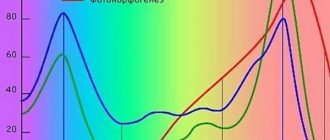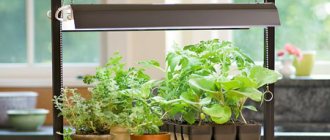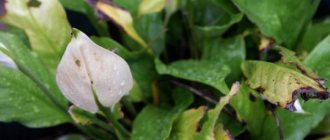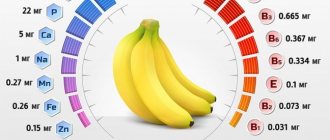Recently, many different phytolamps have appeared in stores. For our latitudes, where there is a pronounced seasonality, they sometimes become a salvation for plants, especially in winter, when the duration of daylight hours is minimal. This negatively affects the growth and well-being of indoor “pets”. You can increase the duration of daylight hours with the help of phytolights. In this article we will tell you how to choose a phytolamp for indoor flowers and talk about the advantages and disadvantages of each type.
Why is additional lighting used when growing 2. What do the different lights of lighting fixtures mean 3. Types of lighting fixtures
Photo: Indoor “pets” require additional lighting.
Check the spectrum of diodes in the phytolamp
It is well known that plants require sunlight, consisting of waves of different lengths and colors, to grow and develop. In the spring, during the period of growing seedlings, when there is not enough sunlight, artificial lighting lamps are usually used to illuminate the plants. However, their emission spectrum is limited and occurs mainly in the yellow and green color sectors. In addition, incandescent lamps consume a lot of electricity. Fluorescent and modern energy-saving lamps are more economical, but emit little light in the red and orange spectral regions. And plants respond well with response growth to blue and red colors.
This optimal combination of colors was achieved by using LEDs in phytolamps. Therefore, these lighting sources are called bicolor. To choose the right lamp, you need to look at the so-called spectrogram (see Figure 1). It is also on the packaging of the lamp itself. The spectrogram should have peaks in the blue and red sectors of the spectrum. In the blue sector, the optimal wavelength for seedlings is 440-450 nm, and in the red sector – 650-660 nm. If the spectral indicators deviate strongly in both directions, such a lamp is not worth buying, since waves of other lengths are ineffective for seedlings.
Picture 1
What is a phytolamp
Seedlings are grown at home or in greenhouses. In both options, the use of phytolamps may be required. This is a special ultraviolet illumination that can completely replace natural light. The use of the device is especially in demand in winter, when daylight hours are short and most often cloudy.
The phytolamp differs from conventional lamps in its color spectrum. Our eyes perceive white and yellow light, but plants need blue and red spectrum. With this lighting, the process of photosynthesis goes better (seedlings gain growth, the stem and root system become stronger).
Distinguish between real and rated diode power
Diodes come in different powers - 1 W, 3 W or 5 W. For the needs of a “home greenhouse,” the most suitable are emitter lamps with a primary lens that scatter light at an angle of 120 degrees. A 3 W lamp with the correct ratio of emitted light and heat is considered optimal.
In order not to make a mistake when choosing a lamp, you need to distinguish between the concepts of nominal and real power. Let's figure out what they mean. Rated power is the power at which the diode operates at its maximum limit. This means that the “life” of the diode under such a load will be short. To make diodes last longer, they are “powered” at half their power, that is, a 3 W diode will actually “show” 1.5 W. This is its real power. Self-respecting manufacturers of LED lamps are required to indicate this information on their websites (see Figure 2).
Figure 2
How much and when is it better to turn on the lighting?
Indoor plants do not require round-the-clock lighting ; it is useful for them to spend the night in the dark. On average, the lamp needs to be turned on for 12 hours every day. At a time when the room is bathed in the rays of the sun, the flowers do not need a lamp. The LED lamp does not suffer from long-term operation and can be used around the clock.
Each type of plant has its own lighting needs. Exactly how much light you need also depends on the season and life cycle. We recommend that you read the recommendations of experts to choose the best option for your home greenhouse.
Correctly calculate the power of the LEDs in the lamp
How to calculate the total power of LEDs? How many diodes should there be in a lamp? The answer to these questions depends on your specific situation. The most important thing in the choice is the relationship between the diode and the radiator (more on this in paragraph 6).
The formula for calculating the number of diodes is quite simple: M = K × M1 , where M is the total power of the lamp (W), K is the number of diodes, and M1 is the power of one diode. However, not all manufacturers are completely honest with customers. In order not to fall for the bait, we will close the gap in knowledge.
Let's say you choose a lamp with a power of 54 W and 18 diodes from Aliexpress, where the manufacturer claims that the power of each diode is 3 W. If you measure it with a wattmeter (a device for measuring the power of connected devices), it turns out that it produces 11 W.
It must be taken into account that the diode cannot operate at maximum for a long time! So, let's calculate: 54 W divided by 18 diodes, we get 3 W for each diode, which work at full capacity! But this cannot be! However, you are paying for 54 watts of rated power and 27 watts of actual power (see information above.) But when measured, it produces 11.6 watts. This is a far cry from 27W.
The real output of the diode is half the power. Then if we take 1.5 W of the power of each diode and multiply it by 18 diodes, we get that this lamp should consist of at least 27 diodes, and not 18, as it actually is. Deception? No, it’s just that there are diodes of lower power, that is, 1 W, which operate at half their power. Manufacturers, of course, do not write about this.
But how did this happen? We take 11.6 W of real power from the outlet, divide it into 18 diodes. And we get 0.64 W! That is, 0.64 W is almost half of 1 W.
Now we take the Minifermer.ru lamp. The packaging says that the lamp consists of 12 diodes with a power of 3 W - in total this is 36 W, that is, the real power from the outlet should be 15-18 W. This is true!
This means that the lamp contains exactly 3-watt diodes! They will work for a long time, and at the same time you will get good results. So the information for the lamp must indicate both the rated power and the real one.
Advantages and disadvantages of such lighting
Below are the key differences between a phytolamp and an ordinary incandescent lamp - its main competitor.
Advantages:
- less energy consumption (savings up to 30%);
- slow heating (leaves do not get burned);
- long service life (50 – 60 thousand hours).
Flaws:
- High price.
- Harm to the eyes.
At the same time, the phytolamp is easy to purchase, it is easy to use and does not require special conditions for operation. However, you will have to calculate their number and distance from the plants.
Consider the radiator area
The radiator is an aluminum housing, which in base lamps is located in a circle or, if it is a linear lamp, the entire housing is the radiator. In Figure 3, the radiator is indicated by arrows.
Figure 3
The heatsink is designed to disperse the heat produced by the diodes. Therefore, the volume of the radiator must be designed for the number of diodes so that they do not overheat. The maximum temperature on the diode crystal should not exceed 70-75°C, otherwise they will “degrade”. That is, if there are many diodes in a lamp and the radiator is small, such a lamp will quickly fail.
Figure 4
In order for the LED phytolamp to work properly, the ratio between the radiator area and the number of diodes must be well adjusted. The distance between the diodes is equally important, that is, if there is enough space between the diodes, the heat is distributed faster. An example of the correct “fitting” of diodes on a radiator is shown in Figure 4.
You can find out detailed information about LED phytolamps from the following video:
Installation recommendations
Depending on the type, the lamp is placed at a distance of 25-50 cm from the plants. It should be above the foliage, because side lighting will cause deformation of the shoots.
Number of lamps
For most flowers, illumination of about 8,000 lux (lux) is sufficient. For example, you can take a 60 W induction lamp, which creates a light flux of 4800 lm (lumens). If the lamp is installed at a distance of 30 cm from the plants, the luminous flux will decrease by 1.3 times, which means that the plants will receive the following amount of light: 4800/1.3 = 3692 lumens. Provided that the area of the box with plants is 1 m2, the required amount of lighting is: 8000 lux × 1.0 m2 = 8000 lm.
So, a 60 W lamp installed 30 cm from the flowers produces 3692 lumens of illumination. You can calculate the required number of devices: 8000/3692 = 2.16. We need to round to the nearest whole number, which means we get two phytolamps. Manufacturers often indicate the lighting area in m2, which makes choosing a lamp much easier.
Power
The lamp power is selected based on the following parameters: the distance between the plant and the device, the presence of a light reflector and the type of plant (partial shade, bright or moderate lighting). For moderate illumination of 1 m2 of plants, an incandescent lamp with a power of 400 W or 5500 lm is required. This means that for a surface 1 m long and 0.5 m wide, the required amount of lighting is 2750 lm.
Important!
If the lamp is placed at a level of 30 cm from the foliage, the luminous flux will decrease by 30%.
Energy efficiency
Energy efficiency is a metric that tells you how much light a lamp emits from every watt of electrical energy. Using this indicator, you can determine the cost-effectiveness of using a phytolamp.
LED Strip Light
LED and fluorescent devices are considered the most suitable for illuminating flowers. They are the most economical to operate, do not heat up (which eliminates the possibility of burns), and stimulate flowering and full growth of flowers.
Life time
Modern LED devices have a long service life - up to 100,000 hours. For comparison, you should familiarize yourself with the operating time of other devices:
- sodium - from 12,000 to 20,000 hours;
- metal halide - from 6,000 to 10,000 hours;
- luminescent - from 10,000 to 15,000 hours;
- induction – up to 60,000 hours.
On a note!
Do not forget that the closer the device reaches the end of its service life, the lower its radiation becomes. At the very end of the period, the percentage of illumination is about 54% of the original.
Consider the distance from the lamp to the illumination area
At what distance from plants should phytolamps be placed? The answer to this question will depend on the room and how many plants you plan to grow, as well as the length of daylight hours.
| Real lamp power | Distance to plants | Area coverage (diameter) |
| 7-10 W | 20-30 cm | 25-30 cm |
| 10-15 W | 35-40 cm | 45-50 cm |
| 15-20 W | 40-45 cm | 85-90 cm |
To ensure that the lamp retains its functions and the effect of such lighting does not decrease, it can be equipped with additional lenses in order to narrow the beam of light. The area of illumination will depend on the selected lenses. In order not to overpay for extra lamps and unnecessary power, it is better to select them with the help of professionals.
The best lamps for plants.
- “Health Treasure” for plants 16 W, 56 cm. Full spectrum LED lamp. Combines blue, red and white colors. Height adjustment from 10 to 500 mm. Power 16 W. Simple design and installation. The price is about 2000 rubles.
Pros. Reliable fastenings, light does not irritate the eyes, economical.
Minuses. Short cord: 1.5 m.
Health treasure
- Jazzway PPG T8i- 900 Agro 12w IP20. Suitable for fruit-bearing plants. Red to blue ratio: 5 to 1. Suitable for home use. Suspension. T8 lamp. Power 12 V. Service life 25,000 hours. Length 880 mm. The price is about 1000 rubles.
Pros. Availability. Fastenings included. Easy. Possibility of adjusting the height of the suspension.
Minuses. Light flux angle 120⁰. Pink light irritates the eyes.
Jazzway PPG T8i- 900 Agro 12w IP20
- SPB-T8-Phyto. The lamp is suitable for the most capricious seedlings: emphasis on the development of roots and stems. The kit includes two lamps, mounts and wires. Base G13, T Price about 1000 rubles.
Pros. Reducing the intervals between waterings. Does not heat up - minimum distance from plants.
Minuses. The cord is short, the light strains the eyes.
SPB-T8-Fito
- Ladder-60. Pendant lamp 60 cm long. Suitable for greenhouses and home use. LED. Red to blue ratio: 4 to 1.
Pros. Waterproof, high luminous flux, does not heat up.
Minuses. High price (about 9,000 rubles), unpleasant light.
Leader-60
- Related Posts
- How to choose and make your own garage lighting
- Sodium lamp (HPS) features and characteristics
- Reasons for blinking tape
Consider installing additional lenses
As mentioned earlier, the diodes already have a primary lens and an illumination angle of 120 degrees. But if you hang the lamp too high, less light will reach the plants and it will be more scattered. That is, the light will cover an unusable area. This use is ineffective, but you will have to pay extra for electricity. Installing additional lenses will help solve this problem. They come in 15, 30, 45, 60, 90 degrees. Selecting a lens will make it possible to choose the desired height and maintain the useful lamp power needed by the plants.
How to determine that a plant is not getting enough light
Shade-tolerant plants require light levels from 1000 to 5000 lux, and light-loving plants require light levels from 10,000 lux.
You can measure the level with a special device. But if it is not there, and this is usually the case, then the plant itself will tell you when there is not enough light for it. Insufficient lighting affects the appearance of any plant. First, the natural color of the leaves changes: young leaves grow pale and small, leaves with variegated colors (scindapsus, variegated ficus and ivy) lose the brightness of the pattern, sometimes becoming simply green. In many species, the lower leaves turn yellow and sometimes fall off.
In almost all species, shoots are noticeably elongated and bent towards the light. If you compare the distance between leaf nodes that grew in summer and those that appeared in autumn or winter, the difference is very noticeable. For example, in pelargonium, the internodes lengthen by 2-3 times.
An experienced gardener will never wait for his plants to stretch out and begin to lose leaves. First of all, you need to know exactly whether a particular species is shade-loving or needs bright light, which can be found in the encyclopedia of indoor plants. And if there is a suspicion that the house flower is dark, then you should definitely install lamps for illumination.
Many novice flower lovers, having learned about the possibility of using artificial lighting, begin to illuminate plants around the clock. But, contrary to expectations, they languish. In the dark, plants also undergo processes necessary for life. Regular alternation of day and night is important. The flowering of many species depends on changes in these periods.
Select a lamp of the desired spectrum
Bicolor spectrum - the main spectrum for giving the plant the energy necessary for photosynthesis. A lamp with this spectrum is recommended:
- for illuminating any plants on the windowsill, balcony and in places with minimal sunlight;
- for growing seedlings and young plants;
- for additional illumination of adult plants indoors with additional light sources;
- to support plants in winter and in low light conditions.
Full spectrum. These are bicolor lamps with a wider range of peaks in the red and blue fields. They are universal and will suit many plants. In terms of energy efficiency and spectrum peaks, these light sources are slightly inferior to bicolor lamps, but due to a wider spectral zone they allow the plant to receive maximum artificial light, similar in effect to solar light.
There are more advanced lamps - these are full-spectrum lamps with the addition of white light. They are suitable for use in places where people live. The light from such a lamp looks warm white, but contains wavelengths useful for plants.
Multicolor spectrum is a unique lamp that combines red, blue, warm white and far red light. It provides maximum stimulation of flowering and fruiting in many plants, including orchids and adeniums, as well as a large proportion of red and blue light for photosynthesis during the growth stage. A lamp with this spectrum is recommended:
- for illuminating adult plants;
- to stimulate flowering and fruiting;
- for growing indoors in the absence of sunlight;
- for additional illumination of indoor flowers, especially orchids;
- for illuminating decorative foliage plants.
The average recommended time for additional illumination with phytolamps is 13-14 hours a day. These lamps can be used not only to extend daylight hours, but also to replace it in a dark room. At night, plants take a break because, like humans, they have a biological clock, and they need “sleep” at night.
Peppers, tomatoes, eggplants, and cucumbers are recommended to be illuminated for 8 to 13 hours a day. Green crops (salads) - 8-11 hours a day, slow-growing plants (celery, radishes, turnips) - 12-16 hours a day.
Types of phytolamps
Types of devices for illuminating plants at home:
- Gas discharge sodium. Such lamps distribute light in all directions, which is not very convenient for home use. When installing in a home, reflectors must be used. The downside is that the surface heats up, you need to monitor the installation level. Water should not come into contact with a working lamp. This may damage the light source.
- Metal halide. The flask contains halogen vapor. The glow is produced in green and yellow-orange shades. The blue spectrum is not clearly expressed, but its quantity is sufficient. This glow is especially useful for plants in the early stages of development. The lamp promotes the proper formation of the root system. The device is demanding on voltage stability.
- Mercury gas discharge. No additional hardware required. The flask has a mirror coating, which forms a stream of light directed to the seedlings. The lamp emits the red spectrum necessary for photosynthesis. The use of such lighting sources can completely replace sunlight. Full operation occurs with a constant supply of voltage.
- Fluorescent - a type of gas-discharge lamps. For plants, you need to buy a “phyto” variety or a regular lamp with a 6400K spectrum. The phytolamp can have a pin or regular base. Linear distribution requires a starter. It is a safe light source with low energy consumption. For full lighting you will need two or more light bulbs.
- LED phytolamp. You can buy either individual diodes or a strip of the required power. It should be taken into account that the red range predominates in the tape, which is responsible for growth and flowering, and the root system needs blue light. Therefore, it is necessary to additionally buy a blue strip and add it to the phyto-LEDs. The advantage is that using strips of different luminescence spectrums, you can independently assemble the desired lamp.
Buy phytolamps with a guarantee
This is a very important point. Manufacturing companies and conscientious sellers must issue a warranty for the lamp. It is very important. If you buy a lamp from an unverified seller, you will not be able to prove to him that it failed not through your fault, but, for example, due to a power surge. And not everyone will undertake to repair such a lamp. Therefore, choose LED bulbs that come with a minimum 1-year warranty.
Some companies, including Minifermer.ru, offer post-warranty service, which is also important. After all, if one diode fails, it will be replaced immediately. And you don't have to figure out which diode is needed and how to solder it.
If you are an avid summer resident who is used to “preparing the cart in winter,” take care of the future harvest now. With lamps from the Minifermer.ru company, your seedlings do not face a lack of light and heat on the windowsill.
Making a lamp for flowers with your own hands
You can make a phyto-lamp yourself at home. Such a device will cost much less than one purchased in a store. The easiest way to assemble an LED lamp is by selecting LEDs by power and color. To design the simplest model, you need to select elements with a power of 3 Watts in the following proportion:
- one green;
- one white;
- four blue with a light wavelength of 445 nm;
- ten red ones with a light wavelength of 660 nm.
Do-it-yourself phytolamp
LEDs are attached using thermal paste to an aluminum radiator plate. After mounting, they are soldered and connected in series with wires, after which they are connected to a driver that will match the current strength. And a fan is attached to the back of the radiator (you can use a fan from the computer system unit).
You may be interested in:
Do-it-yourself lighting for seedlings Not a single living organism is capable of existing without light. Plants, especially in the initial stages, need...Read more...
How to calculate the optimal power of a phytolamp
To do this, you should study the information on the packaging of the phytolight from the manufacturer. To calculate the required power, you need to decide on the type of light culture and, taking into account the planting area for each light culture, its requirements for the power of the light flux at a distance, select the required number of phytolamps of a certain power. The table shows the indicators for each plant type.
| Culture | Power per 1 m2 in W |
| Seedlings and greens | 50-80 |
| Root crops, ornamental crops | 50-100 |
| Vegetables at the ripening stage | 100-170 |
| Berries | 150-200 |
Why do you need additional lighting for seedlings?
Thanks to artificial light sources, it is possible to grow seedlings in the complete absence or insufficient lighting. Electric lighting devices have a different set of spectra aimed at activating physiological processes in plants.
With their help, photosynthesis reactions are launched and new compounds are formed. Thanks to them, seeds quickly germinate into sprouts and adult plants, which after a short period of time produce excellent harvests.











